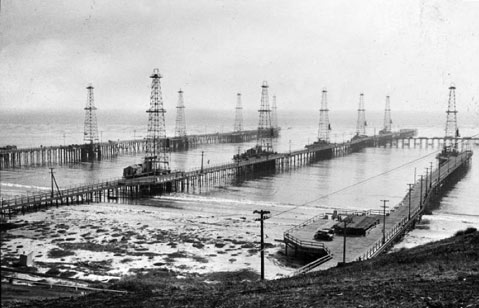Ellwood Bombing
A yearlong exhibition in the society’s History Education Center behind Stow House was unveiled in February and will run until the end of December 2012.

It’s been 70 years since the wartime shelling of the Ellwood oil fields by a large Japanese submarine, and the Goleta Valley Historical Society is seizing the occasion to show that history reverberates through the decades. A yearlong exhibition in the society’s History Education Center behind Stow House was unveiled in February and will run until the end of December 2012.
Education Coordinator Jim McNay and his team of volunteers searched for months to find World War II–era uniforms and civilian clothes to display. Blowups of 1942 newspaper and magazine photos and articles will join cannon-shell fragments, many loaned by private collectors, as part of the atmosphere.
“Ellwood was not a turning point in World War II, but for a blink of an eye, this place made world news,” said Ken Hough, a PhD candidate in history at UC Santa Barbara. It rallied area people to raise funds for the war effort, Hough continued, specifically to buy a fighter plane they proposed to name The Ellwood Avenger. Money was quickly collected, and the U.S. Army Air Corps accepted the warplane.
This type of public response suggests the mix of fear and outrage then gripping Californians.
Even before the 1942 shelling, strong emotional currents were in play in Sacramento and Washington, D.C., sometimes drawing on the long history of West Coast anti-Asian racist feelings and stereotypes. Cries for the evacuation of “enemy aliens” from the West Coast were heard from private individuals and public officials, including California’s entire congressional delegation.
Four days before the sub’s cannonade, President Franklin D. Roosevelt signed an executive order — EO 9066 — that allowed military commanders to remove residents from restricted military zones along the Pacific Coast. The order launched a national internment program that was primarily used against 120,000 persons of Japanese ancestry.
Two-thirds of the people interned were American citizens. Among them were Kenji and Miye Ota, who were born in Lompoc and Oso Flaco, respectively. Today they are widely known in Goleta as instructors par excellence of dance and aikido martial arts. But in the dark days of 1942, they and their families were considered potential spies or saboteurs, and they were sent without a hearing to the high desert camp at Gila River, Arizona. There they lived for the next few years.
The Otas don’t dwell on the camp’s hardships, preferring to recall their meeting and subsequent courtship in that sand-scoured, treeless place the government had confiscated from the Gila River Indian tribe. Eventually, Ken and Miye were released and made it to Philadelphia, where they married, and Miye established a home-based beauty salon.
In 1948 they resettled in the Goleta Valley and made a new start with their newborn son, Steve, and Miye’s home beauty business. “They liked my work,” Miye said of her clients, citing a who’s who of Goleta farm and ranching families that regularly visited the Otas’ modest Old Town home, including the Sextons, the Cavalettos, and the Hollisters. Slowly the Otas’ lives resumed familiar patterns.
Amanda De Lucia, director of the Goleta Valley Historical Society, has said this commemoration will “explore the ramifications of [the shelling] for our community and country.” She added that the society’s oral history project would also welcome residents with stories they wish to share. Recognizing the 1942 event’s deeper connections, like those in the Otas’ story, has an important place in Santa Barbara history and will hopefully be a focus of more than one talk.
4·1·1
“Avenge Ellwood!” The Japanese Attack on California runs February 19-December 30 at the Goleta Valley Historical Society (304 N. Los Carneros Rd.). For info, call (805) 681-7216 or visit stowhouse.com.



